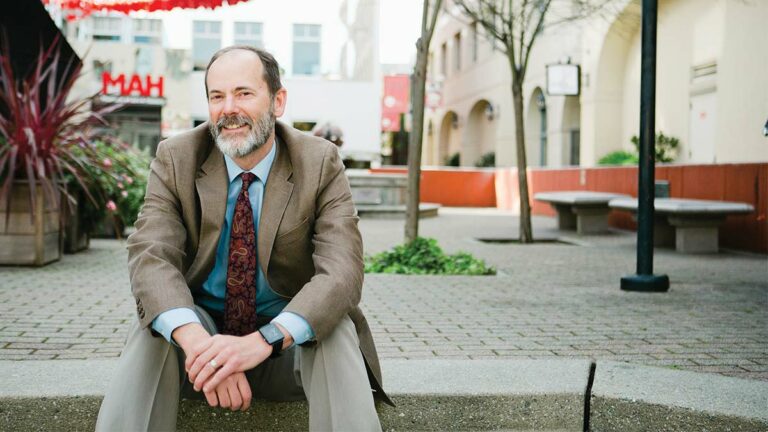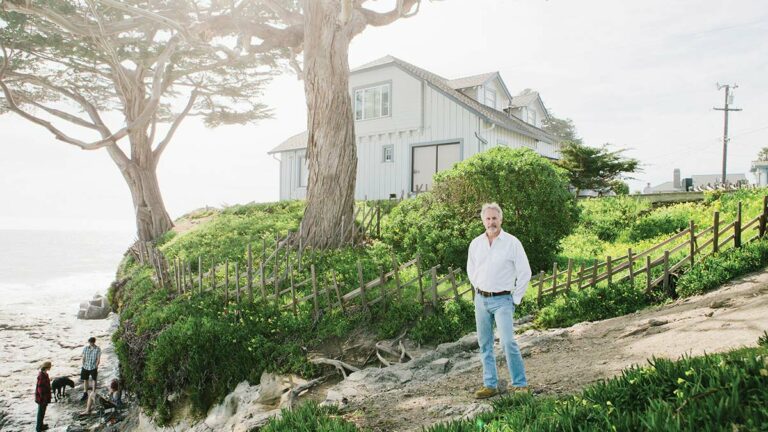From his living room window, Larimore Cummins has watched Santa Cruz’s coastline fall away into the ocean, rock by rock, for nearly 30 years.
Before he sold in 2014, Cummins lived at 1307 West Cliff Drive, a blue house perched on a rocky outcropping, the only residence on the iconic strip’s ocean side.
According to the U.S. Geological Survey (USGS), Santa Cruz County’s bluffs erode around a foot per year—but Cummins says that statistic doesn’t tell the real story.
Cliff retreat is not a slow, steady march eastward, but a series of leapfrogs, occurring in dramatic episodes in various spots, one big chunk at a time.
“It’s so intermittent. It’s asymmetric and discontinuous,” Cummins says.
Unlike much of Santa Cruz’s Westside, his house was on a southeast-facing bluff, relatively sheltered from big waves. Still, twice after large storms in the 1980s and ’90s, he installed large rocks along his cliff edge to underpin the soil and natural rock—an expensive project, he says.
Cummins now lives in Scotts Valley. He’s philosophical about how coastal cities can respond to cliff erosion, opening up big policy questions.
“Should we let nature take its course? Of course, that’s a societal question, and not a scientific question,” Cummins says. “Mother Nature will take its course. The question is, if the first chunk of road goes, and then we have another—do we fix it or do we not?”
How Erosion Works
Several factors cause the disappearing act, but the main cause is the repetitive pounding of waves, thousands of times a day, on fragile cliffs, says Gary Griggs, director of UCSC’s Institute of Marine Sciences and a professor of earth sciences, who has studied local erosion for decades.
This winter has the largest waves on record, and wave energy is 30 percent higher than average, according to the USGS.
The bigger the wave and the higher the tide, the greater the damage—and in El Niño years like this one when sea levels rise, the threat of cliff failure also increases.
Another factor is the hardness of the cliffs. North of Santa Cruz to Año Nuevo State Beach, the cliffs are made of tough mudstone, relatively resistant to erosion. But from Santa Cruz’s Almar Avenue south to Rio del Mar, the cliffs are younger and made of softer stuff, says Griggs, a mixture of sand, silt and mud.
These cliffs are more likely to crumble, which is why the bay curves so far inland, Griggs says.
Barely successful
Seawalls are the most common defense against erosion. More than 25 percent of the county’s coast is armored, such as at Pleasure Point, where Santa Cruz County Public Works and the county’s now-defunct redevelopment agency completed a 20-year, $10.7 million project in 2014 to repair the bluffs and narrow East Cliff Drive. Another estimated $3.8 million seawall project between 5th and 7th avenues in Santa Cruz goes to bid this spring, after a decade in the making. But these costly, intensive measures are not failsafe, and eventually the ocean wins, says John Presleigh, Santa Cruz County Public Works director.
“We built the seawalls to buy some time, but over a period of 50 years, things change,” Presleigh says. “It’s just a constant. There’s a constant retreat of the cliffs in certain areas that you have to be prepared to deal with.”
Much of Santa Cruz, especially along West Cliff Drive, not only has a seawall, but also thousands of tons of rubble at the wall’s base, meant to absorb the brunt of wave energy. But after the area was battered by large surf this January, a sinkhole opened in a parking lot near Woodrow Avenue and West Cliff Drive. The sinkhole—25 feet deep and 20 feet across—formed after waves crept through a hole at the wall’s base, washing away the sediment, says Mark Dettle, Santa Cruz Public Works Department director. The sinkhole is “fairly stable,” but the department is rushing to get the repairs out to bid before the next series of large waves and high tides.
Dettle says erosion’s forces are relentless—even the large four-to-six-ton pieces of rubble move around in large waves, and the city needs to constantly restack them, he says.
“We’ve been barely successful,” says Dettle. “Not that we’ve had any failures, but there’s no guarantees when you’re dealing with the ocean, because you really don’t know when the storms and high tides line up. We design for that case, but we’re kind of at the mercy of the ocean when a significant storm comes through.”
New science
In fall of 2014, USGS began to monitor sand movement along county beaches to help predict coastline change.
The study runs like an orchestrated military operation: Twice a year, scientists walk and drive ATVs down the beaches from Steamer Lane to Moss Landing, taking GPS measurements to form a three-dimensional map. Scientists on jet skis, equipped with echosounders, form a similar map of underwater sand. From planes, scientists take photos and use laser scanning to measure cliff changes.
Patrick Barnard, USGS researcher and one of the project’s leaders, says that beaches are the first natural line of defense against cliff erosion, since on wide beaches, waves are less likely to reach the cliffs. Beaches are seasonal—in the winter, waves pull sand to offshore sandbars, narrowing beaches, and in the summer, sand returns onshore.
The USGS is also measuring another type of sand movement. In the winters, when most of the waves come from the northwest, sand is pushed southward along the shore, until it hits the jetty at Moss Landing, where it tumbles down the Monterey Canyon, deep in the Monterey Bay, essentially lost forever.
Sand is historically replaced by the river outflow, but due to the drought in recent years the amount of sand coming from the rivers has likely dropped, researchers say, which could mean less sand on county beaches.
“As sea level goes up, you need more sand to keep the beaches in their present position,” says Barnard. “So if we’re losing sand, and on top of that, the sea level is going up, we have a double whammy. We have a huge sand deficit. If we look out the next few decades and the next century in particular, we’re going to be in a dire situation.”
This fall, with the help of a local pilot, USGS researcher Jon Warrick began taking monthly aerial photos of the coastline from San Francisco to Monterey.
Warrick says he has not yet seen dramatic erosion this winter in Santa Cruz County. The most obvious changes have been in Pacifica, where the city declared a state of emergency and an apartment building was evacuated after January storms left it teetering on a cliff’s edge.
Capitola’s Depot Hill, Opal Cliffs, Pleasure Point, and Westside of Santa Cruz, typically hot spots for erosion, have so far seemed relatively stable this winter, Warrick says.
However, at Pajaro Dunes south of Watsonville, Warrick says he’s noticed the high tide line nearly reaching some of the houses during big storms, so there’s a potential for flooding.
“You know, we’re kind of in a pickle,” Warrick says. “We have a fantastic town sitting on an eroding cliff. People’s homes and infrastructure, that’s worth a lot of money. It costs a lot of money to have to replace it. We’re really in a difficult place as a community, but it’s a problem that’s echoed in community after community up and down the West Coast.”
Adapting to change
For Griggs, seawalls are not a reliable, long-term solution. A wall at Beach Drive in Rio del Mar lasted less than one winter and the timber wall at Seacliff State Beach has been rebuilt nine times in 60 years, he says.
“We cannot hold back 10,000 miles of Pacific Ocean,” says Griggs. “And it’s not about if sea level is rising or not. We know it is rising—it’s about how fast and how soon and how do we adapt to it.”
At some point, people in erosion-prone areas will have to cede to the ocean, Griggs says. For example, after years of trucking sand down Ocean Beach, San Francisco has a plan to move its coastal Great Highway inland, due to bluff retreat.
It’s what happens when coastal cities realize they can’t hold their position any longer, he says.
“It’s managed retreat,” Griggs says. “It’s not something homeowners are excited about, but I guarantee you it’s going to happen—maybe not this year or next year, but we cannot hold back the Pacific Ocean. We’ve got centuries of sea level rise ahead of us. It’s inevitable.”


 Well, it’s been around a long time, and we still need it. But I’m 83 years old, and difficult to change.
Well, it’s been around a long time, and we still need it. But I’m 83 years old, and difficult to change.





